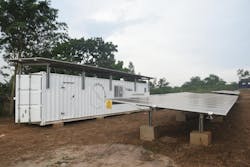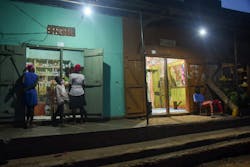Final Results: Uganda’s Twaake Minigrid Pilot Achieved 30x Energy Use, 68% Revenue Boost for Local Businesses
The final results from Uganda’s Twaake Integrated Energy Minigrid pilot are in and they reveal that the Utilities 2.0 model works and could reshape how rural electrification is approached at a national level.
Launched in 2021 in Kiwumu, the pilot delivered electricity access 3.5 times faster than a traditional grid extension, reduced household connection costs, generated a 3,000% rise in demand and spurred economic growth in the village located six miles north of the equator.
The hybrid minigrid included 40 kW of solar and a 140-kWh battery, supplying power to homes, businesses, street lights and a grain milling operation.
Led by Umeme, Uganda’s largest power utility, the pilot was coordinated by Power for All (PfA) as part of the Utilities 2.0 coalition. This coalition includes centralized and decentralized energy companies, nonprofits and development organizations collaborating to accelerate rural electrification through integrated energy solutions. Funding for the project was provided by the Rockefeller Foundation.
Grid interconnection was a core objective from the outset and is a key element of the Utilities 2.0 approach. As such, all customers served during the pilot are now connected to the national grid and the minigrid has since been decommissioned.
The project won the Reuters Global Energy Transition Award for Socially Responsible Project in June 2024 and the Utilities 2.0 coalition is now poised to leverage the pilot’s success and lessons learned to accelerate universal energy access throughout Uganda and the wider region.
In response to emailed questions from Microgrid Knowledge, Alba Topulli, CEO of Power for All, discussed the final outcomes of the pilot and the coalition’s next steps.
Microgrid Knowledge: Did the final analysis reveal any unexpected findings – positive or negative?
Topulli: “Yes, several. The most striking was the speed and scale of electrification. In just six months, nearly 90% of Kiwumu was connected. That’s a dramatic departure from the slow, incremental rollout typical of grid expansion. In contrast, a nearby control site using a conventional approach remained largely unelectrified over the same period.
"The pilot also delivered significant operational and economic gains. Distribution losses fell by over 50% due to smart metering and the levelized cost of energy dropped by two-thirds compared to the control site, to $0.40/kWh, with potential to reach $0.20/kWh at scale, on par with national grid tariffs. Importantly, there were no safety or theft incidents throughout.
"Perhaps most unexpectedly, the pilot revealed the scale of latent demand in underserved communities. Electricity use in Kiwumu grew 30-fold in one year, driven by both household and business uptake. That level of demand typically takes years to materialize—at the control site, it took six years. The takeaway is clear: when power is reliable and affordable, communities respond, and quickly.”
MGK: How long would it have taken to electrify the village without the microgrid?
Topulli: “Kiwumu is just 3 kilometers from the grid, yet it waited over a decade for electricity. That’s not unusual. Across sub-Saharan Africa, urban sprawl is creating a new geography of energy poverty. Recent geospatial analysis is now showing that more than 60% of unelectrified people in sub-Saharan Africa live within an hour of an urban area, and nearly 30% are within 5 kilometers of existing grid infrastructure. But these “grid-adjacent” communities often fall through the cracks of planning frameworks focused either on dense urban centers or remote rural zones.”
MGK: Why are projects like Utilities 2.0 so important in Uganda and in other parts of the world with limited electricity access?
Topulli: “Utilities 2.0 demonstrates that integrated energy models, combining grid, mini-grid and demand-side solutions, can rapidly serve these overlooked areas. In Kiwumu, what had been delayed for ten years was achieved in weeks. It’s a powerful case for rethinking how we define the problem, and who we think is still in the dark.”
MGK: What made the microgrid such an effective solution for cutting connection costs?
Topulli: “Three key levers made this possible. First, connecting a large share of households quickly helped spread fixed costs—370 households (92% of the village) were connected within the first year.
"Second, the project leveraged a national $186-per-connection subsidy, aligned with Uganda’s electrification policy.
"Finally, the integrated approach optimized both generation and consumption, bringing the levelized cost of energy down to $0.40/kWh, with potential to reach $0.20/kWh at scale, on par with grid tariffs.”
MGK: You mentioned that electricity use grew 30-fold in just 12 months. What factors drove the demand to exceed early projections so significantly?
Topulli: “The key driver was how we structured the coalition itself. We moved away from fragmented, one-off demand stimulation and instead aligned all actors—utility, developer, appliance financier and commercial load partner—around a single, shared theory of change: that financial sustainability for the utility would only be possible by rapidly accelerating demand.
"This meant targeting the core challenge head-on: extremely low consumption, averaging just 8 kWh/month, versus a breakeven threshold for the utility of 16–20 kWh/month. To close that gap, we deployed an integrated strategy. Equatorial Power, the mini-grid developer, set a target of achieving 80% household electrification upon powering up the site. Our partner EnerGrow rolled out appliance financing aimed at 30–40% of local businesses, alongside efforts to catalyze early adoption of electric pressure cookers among households. Meanwhile, East African Power worked to develop an anchor load to provide stable commercial demand."
"Crucially, these were not parallel efforts. They were coordinated, sequenced and aligned under a single strategy, and that level of coordination enabled the kind of system-level shift we rarely see in electrification efforts.
"Businesses that accessed appliance financing (nearly half women-led) used 75% more electricity than those without and saw revenues rise by 68%. It’s a model that demonstrates what’s possible when demand stimulation isn’t an add-on, but the central driver of utility and energy investment strategies.”
MGK: How is the pilot program shaping future plans in Uganda, in terms of lessons learned, current expansion efforts and new project development?
Topulli: “The Kiwumu pilot was never intended as a one-off. From the start, it was designed to prove the power of coordinated, public-private innovation—demonstrating how integrated supply- and demand-side interventions can accelerate electrification, reduce costs and deliver stronger returns when aligned under a shared strategy.
"In Uganda, that model has already begun to influence the broader enabling environment. When Utilities 2.0 launched in 2019, there were no clear regulations for interconnection. Since then, we’ve seen concrete policy shifts linked to the pilot [including] the 2021 Isolated Electricity Grid Regulations created space for grid-interconnected systems, the 2023 Energy Policy formally adopted an integrated energy framework, the government established an Interconnection Task Force, chaired by the Ministry of Energy and Mineral Development. This kind of institutional response signals that Uganda is not only supportive, it’s positioned to scale.
"And the case for expansion is strong. Our estimates suggest that a national rollout of integrated energy approaches in Uganda could reach 6.7 million people faster and more cost-effectively than business-as-usual. By aligning grid and off-grid planning, Uganda could reduce grid extension investment costs by 30% and significantly lower household connection fees. At the same time, the mini-grid market alone could expand from 100,000 connections today to 1.5 million, contributing 14% of Uganda’s national electrification target.
"In short, this is not just about expanding access. It’s about better economics, smarter infrastructure and a stronger investment case.”
MGK: Will the program expand beyond Uganda?
Topulli: “Outside Uganda, we’re seeing growing interest in the model. We’re assessing where enabling conditions could support replication—countries with cost-reflective tariffs, connection subsidies, interconnection policies and mechanisms for capex recovery.
"In parallel, we’re rethinking how the market itself is defined. While rural areas remain critical, peri-urban and urban-adjacent areas represent a fast-growing segment of unelectrified households where integrated energy approaches could significantly accelerate timelines and improve the economics of electrification.
"We’ve identified three primary market types where this approach can be applied:
- Markets with reliable power generation but limited distribution infrastructure: In countries where generation is stable and networks are reliable, but grid access is limited, there may be no need to retain solar generation assets post-interconnection. This was demonstrated under the Utilities 2.0 pilot in Uganda.
- Markets with insufficient generation and weak grid infrastructure: In contexts where both generation capacity and grid quality are low, such as Nigeria or Zambia, mini-grids and demand development initiatives remain essential to fill the supply gap and stimulate local demand, even after interconnection.
- High-access markets primed for grid densification and demand stimulation: Countries like Kenya, Tanzania and Rwanda, with national access rates above 75% but persistently low consumption levels, present opportunities to apply integrated approaches as part of grid densification, focusing on stimulating productive and household demand.”
MGK: What does the future hold for Utilities 2.0?
Topulli: “Looking ahead, our focus is twofold: first, to continue generating proof points through new, public/private-sector led, commercial pilots; and second, to help build the enabling infrastructure needed to scale integrated energy approaches. That means aligning policy, planning and finance with on-the-ground delivery, and exploring financing structures and implementation models that enable coalition-driven action.
"Ultimately, our aim is to position integrated energy, across both demand and supply, as a central pillar of national electrification strategies and a core pathway to achieving universal access.”
About the Author
Kathy Hitchens
Special Projects Editor
I work as a writer and special projects editor for Microgrid Knowledge. I have over 30 years of writing experience, working with a variety of companies in the renewable energy, electric vehicle and utility sector, as well as those in the entertainment, education, and financial industries. I have a BFA in Media Arts from the University of Arizona and a MBA from the University of Denver.




